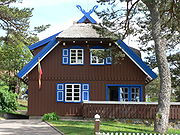
Ašvieniai
Encyclopedia

Divine twins
The Divine twins are a mytheme of Proto-Indo-European mythology.*the Greek Dioscuri*the Vedic Ashvins*the Lithuanian Ašvieniai*the Latvian Dieva dēli*Alcis *Romulus and Remus*Hengest and Horsa...
in the Lithuanian mythology
Lithuanian mythology
Lithuanian mythology is an example of Baltic mythology, developed by Lithuanians throughout the centuries.-History of scholarship:Surviving information about Baltic paganism in general is very sketchy and incomplete. As with most ancient Indo-European cultures Lithuanian mythology is an example of...
identical to Latvian
Latvian mythology
Latvian culture, along with Lithuanian, is among the oldest surviving Indo-European cultures. Much of its symbolism is ancient. Its seasons, festivals, and numerous deities reflect the essential agrarian nature of Latvian tribal life...
Dieva deli and direct counterparts of Vedic
Vedic mythology
Vedic mythology refers to the mythological aspects of the historical Vedic religion and Vedic literature, most notably alluded to in the hymns of the Rigveda...
Ashvins
Ashvins
The Ashvins , in Hindu mythology, are divine twin horsemen in the Rigveda, sons of Saranya , a goddess of the clouds and wife of Surya in his form as Vivasvat. The Ashvins are Vedic gods symbolising the shining of sunrise and sunset, appearing in the sky before the dawn in a golden chariot,...
. The both names derive from the same Proto-Indo-European
Proto-Indo-European language
The Proto-Indo-European language is the reconstructed common ancestor of the Indo-European languages, spoken by the Proto-Indo-Europeans...
root for the horse - *ek'w-. Old Lithuanian ašva and Sanskrit
Sanskrit
Sanskrit , is a historical Indo-Aryan language and the primary liturgical language of Hinduism, Jainism and Buddhism.Buddhism: besides Pali, see Buddhist Hybrid Sanskrit Today, it is listed as one of the 22 scheduled languages of India and is an official language of the state of Uttarakhand...
ashva
Ashva
Aśvaḥ is the Sanskrit word for a "horse", one of the significant animals finding references in the Vedas as well as later Hindu scriptures. The corresponding Avestan term is aspa...
mean "horse". Ašvieniai are represented as pulling carriage of Saulė (the Sun) through the sky. Ašvieniai, depicted as žirgeliai or little horses, are common motifs on Lithuanian rooftops placed for protection of the house. Similar motifs can also be found on beehives, harnesses, bed frames, and other household objects. Ašvieniai are related to Lithuanian Ūsinis and Latvian Ūsiņš (cf.
Cf.
cf., an abbreviation for the Latin word confer , literally meaning "bring together", is used to refer to other material or ideas which may provide similar or different information or arguments. It is mainly used in scholarly contexts, such as in academic or legal texts...
Vedic Ushas
Ushas
Ushas , Sanskrit for "dawn", is a Vedic deity, and consequently a Hindu deity as well.Sanskrit is an s-stem, i.e. the genitive case is . It is from PIE , cognate to Greek Eos and Latin Aurora....
), gods of horses.

